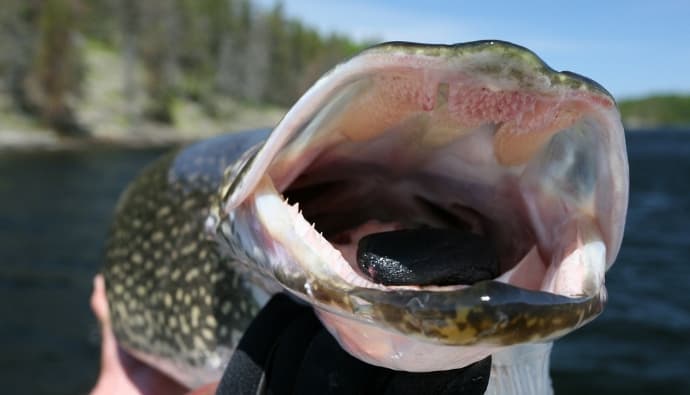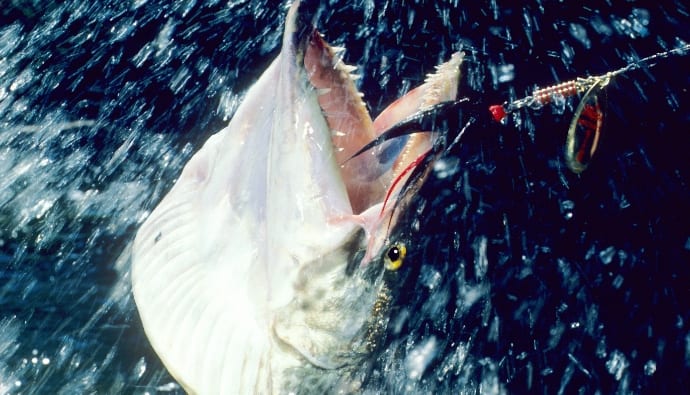There are so many snapper names it’s hard to keep track of more than 100 different kinds of snappers. The snapper is a prized game fish that’s highly sought after.
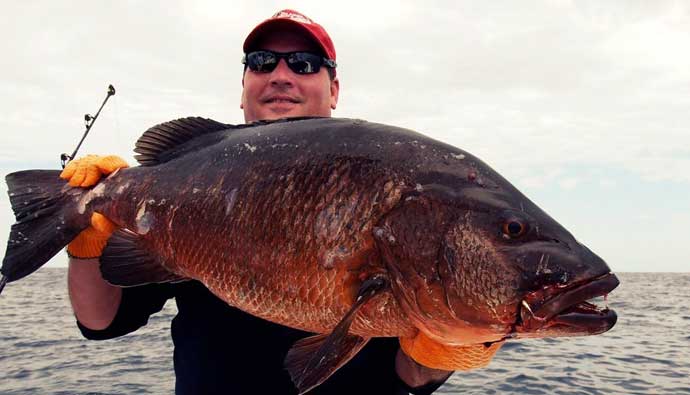
These are members of the large Lutjanidae family of fish. Find them in tropical-subtropical waters in the Indian, Atlantic, and Pacific Oceans.
Overview
If you want to learn how to catch snapper and other tips, you need to learn about the common species you can encounter first. Here are the different snapper names you should know about:
Snapper names
Cubera Snapper
Also known as – Cuban snapper, pargo cabalo and pargo cubera
Scientific name – Lutjanus cyanopterus
Location – Cubera snapper can be found in the western Atlantic from Florida to Cuba right to the mouth of the Amazon in Brazil. Yet, this snapper can be found in New Jersey and in the north of Florida.
Identification – The head, body, and fins of this snapper are steel gray to dark brown in color and some have a reddish tinge as well. Young cubera snappers and some adults sport pale bands on the body. The eyes are dark red in color, the lips are thick, and the snapper has a rounded anal fin. It also has connected dorsal fins that have over 10 spines and 14 rays.
Size – Even though cubera snapper usually weighs about 40 pounds, some can grow to about 100 pounds and grow to be about 4 or more feet long.
Habitat – Adult cubera can be found offshore amidst reefs, ledges, wrecks, and rocky bottoms. Young ones can enter freshwater or mangrove areas as well as grass beds. This snapper is solitary and can be found swimming 60 feet underwater.
Fishing tips – Bottom fishing methods are popular with anglers who want to catch this snapper. Fish for them in wrecks with heavy tackle and using bait such as lobster to attract them. Strikes may be light, but the cubera snapper can hide fast, so you need to be just as quick.
Check out our guide for more information on how to catch Cubera snapper.
Gray Snapper
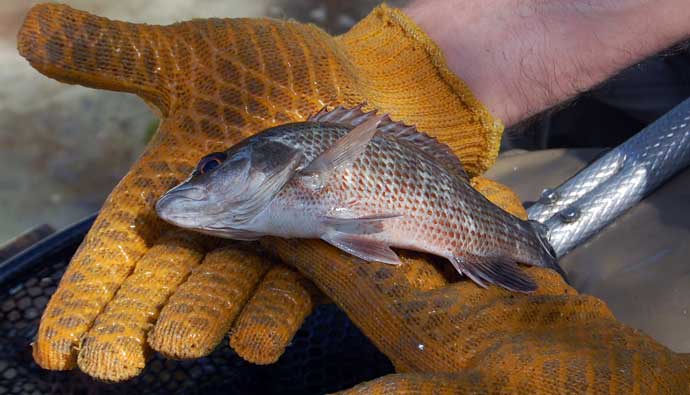
Also known as – Mangrove snapper, sarde grise, caranha, and caballerote.
Scientific name – Lutjanus griseus
Location – Gray snapper can be found in the western Atlantic and from Massachusetts to Rio de Janeiro. It also occurs throughout the Caribbean all the way to Bermuda.
Identification – Gray snapper colors range from dark gray or brown to gray/green. The belly is sometimes tinged with red, and some have orange spots running down the lower sides. A horizontal line runs from the lip through the eye, while the tail has a dark margin. It has two canine teeth at the front of the upper jaw, and the tooth patch is triangular in shape.
Size – Gray snappers only grow to weigh about a pound, but offshore ones can weigh up to 10 pounds and 35 inches in length.
Habitat – Adult gray snapper can be found inshore over smooth bottoms such as estuaries, mangroves, and in meadows of seagrass. Some may also be found offshore over coral reefs and besides rocky outcroppings and shipwrecks.
Fishing tips – This species is caught by bottom fishing methods over uneven terrain. Anglers use electric and manual reels, heavy monofilament lines, and sturdy boat rods to hunt for this snapper. Bait is usually live such as clams and shrimp.
Lane Snapper
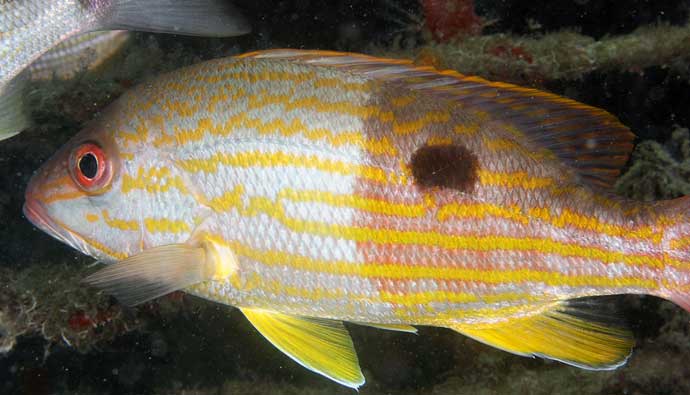
Also known as – chino, machego, villajaib, rayado, lane snapper fish
Scientific name – Lutjanus synagris
Location – Lane snapper can be found in the tropical western Atlantic from North Carolina to southeastern Brazil. This snapper species lives in large numbers in the Antilles and on the northern coast of South America.
Identification – Lane snappers are reddish to silvery pink in color, and they have pink and yellow stripes on the sides. Some may have a green tinge on the back and sides, along with dark bands. The fins are yellow in color, but the dorsal and tail ones are red. Its tooth patch is shaped like an anchor.
Size – Lane fish usually do not grow large enough to weigh more than a pound, and they grow to about 12 – 15 inches long at most.
Habitat – This snapper prefers to live in coral reefs as well as sandy sea bottoms that have plenty of vegetation to hide in. Young ones remain in grass beds or in shallow reefs, whereas adult lanes can be found offshore in larger reefs.
Fishing tips – Lane snapper can usually be found in shallow water, so it is usually caught with baited traps and beach seines. You can also use a hook and line to catch them but be ready to withstand a fight when you are lane snapper fishing.
Lane snapper limits – Check your local regulations.
Yellowtail Snapper
Also known as – yellow striped snapper, creole and rabir-rubia
Scientific name – Ocyrus chrysurus
Location – Yellowtails can be found in the tropical western Atlantic around Massachusetts, Bermuda, and all the way to Mexico.
Identification – This snapper has a yellow streamlined body that is grayish above and silvery-white below. As per its namesake, it has yellowish stripes across its belly. Also, it has a vibrant yellow stripe that starts from the mouth through the eye and all the way to the tail.
Size – Yellowtails usually grow about 2 feet in length at most and weigh up to 3 – 5 pounds as adults.
Habitat – This snapper can be found swimming in tropical coastal waters about 10 to 300 feet underwater around coral reefs. Young ones can be found over grass beds inshore.
Fishing tips – Most anglers use cut-up fish and squid as bait to attract yellowtail snappers and fish on the bottom from bridges and piers. If you are fishing offshore, use chum to attract school. Use a medium-action spinning rod to catch these.
FAQs
Q: What does Lane snapper taste like?
A: Lane snapper has delicate, which tastes as mild as it looks.
Q: How do you catch lane snapper?
A: Lane snapper can be found in shallow water so catch it using baited traps and beach seines. You can also use a hook and line to catch this fish but be ready to withstand a fight.
Q: What does silk snapper taste like?
A: The firm flesh of the silk snapper has a nutty and sweet flavor.
Q: How big do mangrove snapper have to be?
A: Another snapper name you should know is the Mangrove snapper. They should be caught when they are about 8 to 14 inches long.
Insider Advice
The snapper is a popular fish with anglers not because it is a challenge to catch but also because of its sheer variety. If you remain inshore, chances are you will only find young snappers.
Use them to hone your fishing skills before heading out to sea for the bigger ones.
There are so many snapper names it can be hard to keep track if you don’t study up.
Do you have any tips and guidelines about how to catch this fish? Answer in the comments below and do share this guide if you liked it.




 Facebook
Facebook YouTube
YouTube



